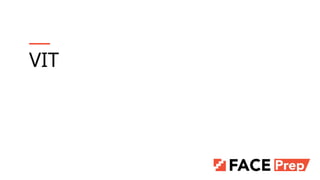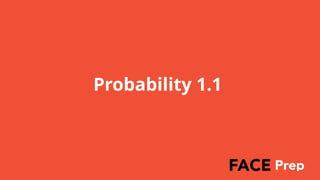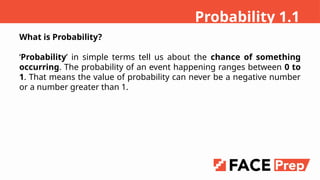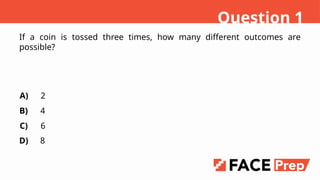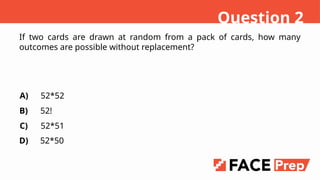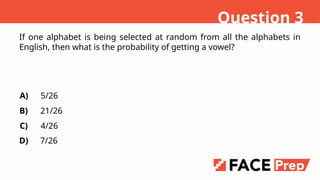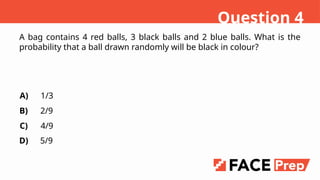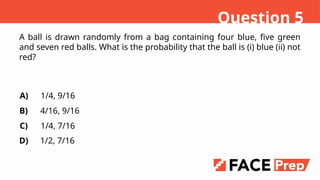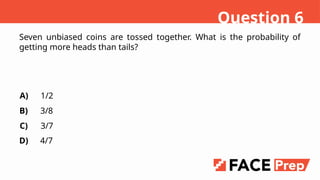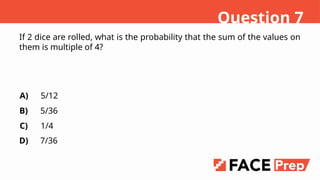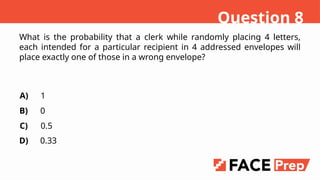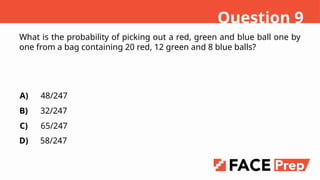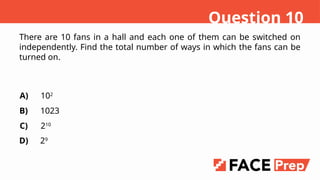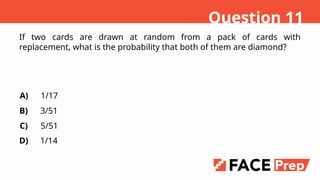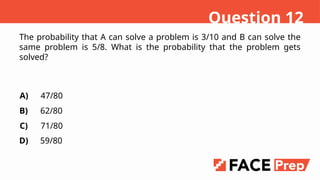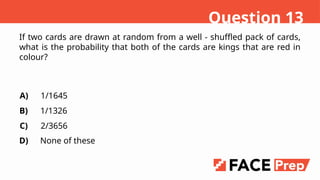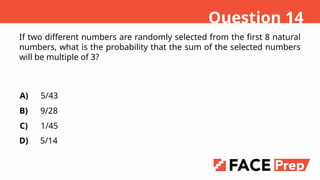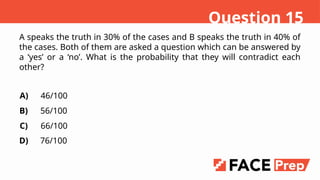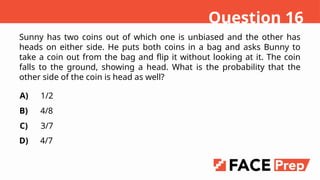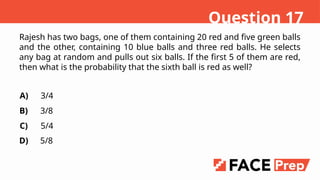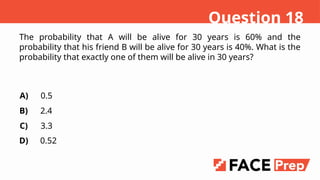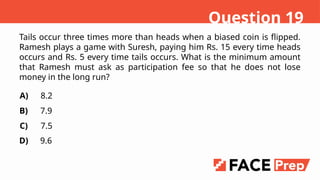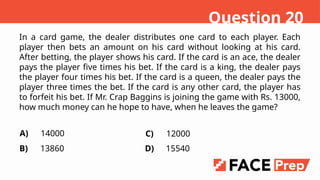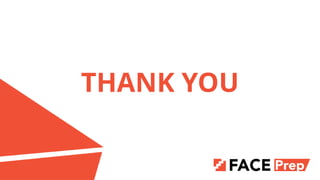29-Probability-01-03-03-2025.pptx29-Probability-01-03-03-2025.pptx
- 2. Topic/Course Sub-Topic (Example: name of college) VIT
- 4. What is Probability? ˇ®ProbabilityˇŻ in simple terms tell us about the chance of something occurring. The probability of an event happening ranges between 0 to 1. That means the value of probability can never be a negative number or a number greater than 1. Probability 1.1
- 5. Consider this, if itˇŻs cloudy outside then two things can happen. First, either it will rain or second, it wonˇŻt rain. So, the total events are ˇ®2ˇŻ (raining or not raining). And, the probability of raining is 1/2 So, Probability of an event happening = Concerned Events / Total Events Probability of an event happening is denoted by P(E) Probability of an event not happening is denoted by P(?). And, P(E) + P(?) = 1 Probability 1.1
- 6. If a coin is tossed three times, how many different outcomes are possible? A) B) C) D) 2 4 6 8 Question 1
- 7. If two cards are drawn at random from a pack of cards, how many outcomes are possible without replacement? A) B) C) D) 52*52 52! 52*51 52*50 Question 2
- 8. If one alphabet is being selected at random from all the alphabets in English, then what is the probability of getting a vowel? A) B) C) D) 5/26 21/26 4/26 7/26 Question 3
- 9. A bag contains 4 red balls, 3 black balls and 2 blue balls. What is the probability that a ball drawn randomly will be black in colour? A) B) C) D) 1/3 2/9 4/9 5/9 Question 4
- 10. A ball is drawn randomly from a bag containing four blue, five green and seven red balls. What is the probability that the ball is (i) blue (ii) not red? A) B) C) D) 1/4, 9/16 4/16, 9/16 1/4, 7/16 1/2, 7/16 Question 5
- 11. Seven unbiased coins are tossed together. What is the probability of getting more heads than tails? A) B) C) D) 1/2 3/8 3/7 4/7 Question 6
- 12. If 2 dice are rolled, what is the probability that the sum of the values on them is multiple of 4? A) B) C) D) 5/12 5/36 1/4 7/36 Question 7
- 13. What is the probability that a clerk while randomly placing 4 letters, each intended for a particular recipient in 4 addressed envelopes will place exactly one of those in a wrong envelope? A) B) C) D) 1 0 0.5 0.33 Question 8
- 14. What is the probability of picking out a red, green and blue ball one by one from a bag containing 20 red, 12 green and 8 blue balls? A) B) C) D) 48/247 32/247 65/247 58/247 Question 9
- 15. There are 10 fans in a hall and each one of them can be switched on independently. Find the total number of ways in which the fans can be turned on. A) B) C) D) 102 1023 210 29 Question 10
- 16. If two cards are drawn at random from a pack of cards with replacement, what is the probability that both of them are diamond? A) B) C) D) 1/17 3/51 5/51 1/14 Question 11
- 17. The probability that A can solve a problem is 3/10 and B can solve the same problem is 5/8. What is the probability that the problem gets solved? A) B) C) D) 47/80 62/80 71/80 59/80 Question 12
- 18. If two cards are drawn at random from a well - shuffled pack of cards, what is the probability that both of the cards are kings that are red in colour? A) B) C) D) 1/1645 1/1326 2/3656 None of these Question 13
- 19. If two different numbers are randomly selected from the first 8 natural numbers, what is the probability that the sum of the selected numbers will be multiple of 3? A) B) C) D) 5/43 9/28 1/45 5/14 Question 14
- 20. A speaks the truth in 30% of the cases and B speaks the truth in 40% of the cases. Both of them are asked a question which can be answered by a ˇ®yesˇŻ or a ˇ®noˇŻ. What is the probability that they will contradict each other? A) B) C) D) 46/100 56/100 66/100 76/100 Question 15
- 21. Sunny has two coins out of which one is unbiased and the other has heads on either side. He puts both coins in a bag and asks Bunny to take a coin out from the bag and flip it without looking at it. The coin falls to the ground, showing a head. What is the probability that the other side of the coin is head as well? A) B) C) D) 1/2 4/8 3/7 4/7 Question 16
- 22. Rajesh has two bags, one of them containing 20 red and five green balls and the other, containing 10 blue balls and three red balls. He selects any bag at random and pulls out six balls. If the first 5 of them are red, then what is the probability that the sixth ball is red as well? A) B) C) D) 3/4 3/8 5/4 5/8 Question 17
- 23. The probability that A will be alive for 30 years is 60% and the probability that his friend B will be alive for 30 years is 40%. What is the probability that exactly one of them will be alive in 30 years? A) B) C) D) 0.5 2.4 3.3 0.52 Question 18
- 24. Tails occur three times more than heads when a biased coin is flipped. Ramesh plays a game with Suresh, paying him Rs. 15 every time heads occurs and Rs. 5 every time tails occurs. What is the minimum amount that Ramesh must ask as participation fee so that he does not lose money in the long run? A) B) C) D) 8.2 7.9 7.5 9.6 Question 19
- 25. In a card game, the dealer distributes one card to each player. Each player then bets an amount on his card without looking at his card. After betting, the player shows his card. If the card is an ace, the dealer pays the player five times his bet. If the card is a king, the dealer pays the player four times his bet. If the card is a queen, the dealer pays the player three times the bet. If the card is any other card, the player has to forfeit his bet. If Mr. Crap Baggins is joining the game with Rs. 13000, how much money can he hope to have, when he leaves the game? A) B) 14000 13860 Question 20 C) D) 12000 15540
- 26. THANK YOU
Editor's Notes
- #6: Answer: D We know that every time we toss a coin we will have two outcomes. So, three tosses => Number of outcomes = 2*2*2 = 8
- #7: Answer: C Given, Without Replacement. => No. of cards = 52 (In all draws) Drawing two cards => No. of outcomes = 52*51.
- #8: Answer: A In English Alphabet, No. of letters = 26 No. of vowels = 5 So, Probability = 5/26
- #9: Answer: A We have three black balls and total of 9 balls. So, the probability = 3/9 = 1/3
- #10: Answer: A Let the total possible outcomes be S. Then n(S) = 4 + 5 + 7 = 16 (i) Let E be the event of getting a blue ball. Here n(E) = 4. So P(E) = 4/16=1/4 (ii) Let the probability of getting a red ball be P(E). So P(E)=7/16 The probability of not getting a red ball = 1 ¨C P(E). So 1 -P(E) = 16-7/16=9/16
- #11: Answer: A Possible combinations for more heads than tails. (4 heads, 3 tails), (5 heads, 2 tails), (6 heads, 1 tails), (7 heads, 0 tails), that is, 4 cases Total possible combinations: (0 heads, 7 tails), (1 heads, 6 tails), (2 heads, 5 tails), (3 heads, 4 tails), (4 heads, 3 tails), (5 heads, 2 tails), (6 heads, 1 tails), (7 heads, 0 tails) That is, 8 cases. So Probability = 4/8 =?1/2
- #12: Answer: C the no of possibilities for getting the sum as multiples of 4 = {(1,3),(2,2),(2,6),(3,1),(3,5),(4,4),(5,3),(6,2),(6,6)}? ? ? ? ? ? ? ? ? ? ? ? ? ? ? ? ? ? ? ? ? ? ? ? ? ? ? ? ? ? ? ? ? ?Total outcomes = 36 ? ? ? ? ? ? ? ? ? ? ? ? ? ? ? ? ? ? ? ? ? ? ? ? ? ? ? ? ? ? ? ? ? ? ? ? ? ?Probability = 9/36 ? ? ? ? ? ? ? ? ? ? ? ? ? ? ? ? ? ? ? ? ? ? ? ? ? ? ? ? ? ? ? ? ? ? ? ? ? ? ? ? ? ? ? ? ? ? ?= 1/4 ?
- #13: Answer: B If one of the letters is placed in a wrong envelope then, ultimately the other letter will also be placed in a wrong one. So, the probability of exact one wrong envelope will be zero.
- #14: Answer: A Probability of choosing one red ball followed by a green and a blue ball= 20/40 x 12/39 x 8/38 Probability of choosing one red ball followed by a blue and a green ball= 20/40 x 8/39 x 12/38 Similarly, there will be a total of six cases. So Total probability= (20 x 12 x 8 x 6) / (40 x 39 x 38)? =?48 / 247
- #15: Answer: B If one of the letters is placed in a wrong envelope then, ultimately the other letter will also be placed in a wrong one. So, the probability of exact one wrong envelope will be zero.
- #16: Answer: A Total events=52C2?Favourable events(selecting 2 diamond card)=13C2 Probability of getting both the cards as diamond cards=13C2/52C2=1/17
- #17: Answer: D The case in which A and B, both do not solve the problem has a probability of (1 - (3/10)) (1 - (5/8)) = 21/80 In all other cases, the problem is getting solved (A solves and B fails, A fails and B solves, A and B, both solve). Therefore, the probability of the problem getting solved is 1- 21/80 =?59/80
- #18: Answer: B 2C2/52C2?= 1/2652
- #19: Answer: D Total events (selecting 2 out of 8) =?8C2= 28 Favourable event (getting a multiple of 3) = (1,2), (1,5), (1,8), (2,4), (3,6), (4,5), (4,8), (5,7), (7,2), (7,8) = 10 Probability = 10/28 = 5/14
- #20: Answer: A Let us take a case when the true answer to the question is ˇ®yesˇŻ. A and B will contradict each other if A says ˇ®yesˇŻ and B says ˇ®noˇŻ or vice versa, that is, A will speak the truth and B will lie or A will lie and B will speak the truth. The probability of this is (30/100 x 60/100) + (70/100 x 40/100) = 46/100 In the other case, that is, when the answer of the question is ˇ®noˇŻ. By symmetry, probability of A and B contradicting each other will be 46/100. Total probability will be 1/2 x 46/100 +1/2 x 46/100=46/100
- #21: Answer: A If Bunny had tossed the unbiased coin, the other side is tail. If he had tossed the biased coin, the other side is the head. Hence, the probability is?1/2.
- #22: Answer: A As the first 5 balls are red, it can be concluded that Rajesh is pulling balls out of the first bag. After five red balls have been pulled out, there are 15 red and five green balls in the bag. The probability of pulling out another red ball is 15/(15 + 5) =?3/4
- #23: Answer: D Probability that exactly one must be alive = A(alive)*B(dead)+A(dead)*B(alive)? ? ? ? ? ? ? ? ? ? ? ? ? ? ? ? ? ? ? ? ? ? ? ? ? ? ? ? ? ? ? ? ? ? ? ?=(0.6)(0.6)+(0.4)(0.4) ? ? ? ? ? ? ? ? ? ? ? ? ? ? ? ? ? ? ? ? ? ? ? ? ? ? ? ? ? ? ? ? ? ? ? ?=0.52
- #24: Answer: C Let the probability of getting a head be x. Therefore, the probability of getting a tail is 3x. But, x + 3x = 1, Therefore x= 1/4 Probability of getting a head is 1/4 and getting a tail is 3/4. Hence, the expected payment that Suresh has to make is (1/4 x 15) + (3/4 x 5) = 30/4 =?Rs 7.5
- #25: Answer: C Assume that Mr. Crap Baggins plays 52 ideal games, that is, he gets a different card in each game and bets Re. 1 in each game. In four games, when he gets an ace, he earns Rs. 5 per game = Rs. 20 in four games. In four games, when he gets a king, he earns Rs. 4 per game = Rs. 16 in four games. In four games, when he gets a queen, he earns Rs. 3 per game = Rs. 12 in four games. In all other games, he earns Rs. 0. So His total earnings in 52 games = Rs. 48. His total expenditure in 52 games = Rs. 52. If he spends Rs. 52, he can expect to have Rs. 48. If he spends Rs. 13000, he can expect to have 48/52 x 13000 =?Rs. 12000

